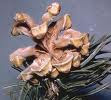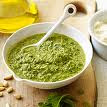 MULBERRIES, TOOT, MORUS ALBA, NIGRA AND RUBRA
MULBERRIES, TOOT, MORUS ALBA, NIGRA AND RUBRAMulberry trees are grown in Europe, Asia and the US. The white mulberry tree (
Morus alba) originated in China where it has been used extensively in medicine as well as for its delicious fruit.
Morus nigra had been cultivated for thousands of years in Europe, and was planted on a wide scale in the belief that silk worms enjoyed the leaves. This proved to be an expensive mistake as they are partial to
Morus alba leaves.
Morus rubra (red mulberry) is native to the US. All mulberry trees have two characteristics in common. The first is that all parts of the tree have a milky sap and the second is that different shaped leaves can grow on the same tree. The leaves are not of a uniform shape. In Pakistan there is a different kind of mulberry tree, the
Shahtoot, which produces large, elongated fruit.

The mulberry tree has its own children’s rhyme and song in Britain. “Here we go round the mulberry bush… on a cold and frosty morning” and children form a circle around someone or something while dancing around and singing this song.
In Europe the mulberry tree has a long history. Mulberry trees were planted in Britain by the Romans and Gerard the herbalist wrote about the trees he had in his garden, both black and white mulberries, as being “high and full of boughes” in the 17th century. The black mulberry variety was probably introduced to Europe from Persia.

We know that the Romans ate mulberries at feasts and Horace recommends (
Satires ii) that they be picked just before sunset. They figure in Ovid’s “Metamorphoses” as Pyramus and Thisbe, the star-crossed lovers whose fate was acted out by Bottom and friends in Shakespeare’s “A Midsummer Night’s Dream”, who were murdered under the shade of a white mulberry tree and their blood stained the fruit so that it became dark red.
Pliny wrote of the mulberry tree, “Of all the cultivated trees, the Mulberry is the last to bud, which it never does until the cold weather is past, and it is therefore called the wisest of trees. But when it begins to put forth buds, it dispatches the business in one night and that with so much force that their breaking forth may be clearly heard.” It could be that the trees are called Morus, which means delay in Latin, because of this fact.
The trees were dedicated to the Roman goddess of wisdom, Minerva.

From Virgil’s
Georgics II verse 121 we know that the mulberry tree grew prolifically in Italy and the Black Mulberry tree is depicted in “The House of the Bull” in Pompeii and mulberry leaves figure in the mosaic in “The House of the Faun” there. In Virgil’s day, (he died in 19 BC) it was believed that silk came from the leaves themselves; the ancients did not understand the silk worms were the manufacturers of silk. Sericulture was introduced much later by the Emperor Justinian from Constantinople, where he ruled from AD 527-65. The poor Italian silk worms were fed on the leaves of the black mulberry tree until 1434 when
Morus alba was introduced from the Levantine lands.
The Holy Roman Emperor Charlemagne ordered the mulberry tree to be cultivated on his imperial farm in AD 812 and Syrup of Mulberries gets a mention in the Calendar of Cordova in AD 961, so clearly they were cultivated in Spain. This Syrup or Syrupus Mori was recognized b the British Pharmacopoeia as being an expectorant, slightly laxative and a good gargle for sore throats. Gerard recommends it thus “The barke of the root is bitter, hot and drie, and hath a scouring faculty: the decoction hereof doth open the stoppings of the liver and spleen, it purgeth the belly and driveth forth worms.”

These days modern medical research is continuing into the benefits of mulberries but they are considered to be another of nature’s superfruits like the
kiwi fruit,
avocado and
pomegranate, as they contain resveratol which is believed to be an anti-cancer agent and may benefit the heart, alleviate chronic inflammation caused by arthritis and arthrosclerosis and postpone the onset of Alzheimer’s and Parkinson’s diseases. Mulberries also contain anthocyanins which are pigments in the fruit and very potent antioxidants which have also shown promising results in fighting cancer. The root bark contains
flavonoids which have diuretic and expectorant properties an can increase the level of insulin in the body and decrease blood glucose. Old mulberry leaves are to be avoided though as they are believed to have tranquilizing properties and may cause hallucinations, headaches and upset stomachs. Use young leaves and twigs for tisanes.

Eating fresh mulberries in season is good for your health, but using the extracts of mulberries for long periods of time is not recommended as they can cause liver and spleen damage. You shouldn’t drink too much mulberry juice or tea or tisanes either as these have the same effect. Allergies associated with the extracts include respiratory problems and chest pains.
Mulberries are rich in potassium, which is an energy booster and helps repair cell damage and also stimulates the immune system. They also lower cholesterol levels.
The leaves and stem contain the
minerals phosphorous, potassium and calcium and act as a diuretic, flushing extra fluids and toxins out of the body. The tisane blocks the absorption of sugars and is useful in a calorie controlled diet. You can make the tisane with fresh or dried leaves by adding 15 gr of leaves to a pot then pouring on just-boiling water and leaving to steep for about 8 minutes. This is good for colds and coughs as well as sore throats.
If you steep leaves in
olive oil or
coconut oil for several days you can use the oil for skin problems and it is especially good for dry or irritated skin. Mulberries generally help the skin and slow its ageing process. If you boil mulberry leaves and put your head over the steam it will act as a good facial cleanser. Remove the pan from the heat and put a towel over your head and then lean over the steam. Afterwards rinse your skin with cold water.

There have been many famous mulberry trees in Britain; one of them was reputedly planted by the botanist Turner in 1548 at Syon House, Brentford. In 1608 James Introduced sericulture (the culture of silkworms) to Britain and an edict encouraged the cultivation of mulberry trees. This was an unsuccessful enterprise however as the trees were of the black variety. One of these trees,(from the four acres of mulberry gardens James I had planted near the Palace of Westminster) was supposed to have been taken to Stratford-upon–Avon by the Bard, William Shakespeare, who planted it at his home in New Place. Descendants from this particular plant were said to be the ones found in Kew, in the Royal Botanical Gardens. The site of James I’s mulberry garden is now the site of the private gardens of Buckingham Palace, but there is only one remaining mulberry tree now.
The tree in Stratford now is said to be a descendant of the Bard’s tree as the original was cut down by the next owner of New Place, one Reverend Francis Gastrell, who reportedly was fed up with people staring at the tree. He was further infuriated by the Land Taxes, perhaps the reason for cutting down the tree and tore the house down too. He was then hounded out of Stratford by the furious locals and no one named Gastrell was allowed to live there again under a local law. So whatever mulberry tree you may now see in Stratford, it is not the original one.
In 1608-9 Christ College Cambridge along with other colleges planted 300 mulberry trees, and the one that grows in the grounds now may be the one tree remaining from that time..

Mulberry trees are very resilient and can continue growing if they have shoots even if they fall down. They can spring up from buds and a dormant bud lying near an old tree can germinate if the original dies. These mulberry trees can grow to around 30 to 50 feet tall, but the American
Morus rubra can grow to heights of 60 – 70 feet. Paper can be made from the bark of these trees and the Maisin people of Papua New Guinea resisted the temptation to sell their ancestral lands- consisting of rainforest- and chose instead to preserve their heritage and make a livelihood from making cloth, called Tapa cloth, from the bark of their mulberry trees. They are being assisted in marketing this cloth by ‘Green’ organizations.
Mulberry fruit, leaves stem, bark and roots have been used in traditional medicine around the world to cure colds, constipation, diarrhoea, headaches, melancholy, hypertension, inflammation, insomnia, snakebites, bronchitis and asthma as well as other ailments, so the trees have many uses and benefits. The side effects come from the older leaves and the extracts on the food supplement market. Eat the fresh fruit in season with immunity.
The syrup in the recipe below can be served over ice cream too. The tea is very refreshing on a hot summer’s day.
 MULBERRY ICED TEA
MULBERRY ICED TEAIngredients
2 cups black mulberries, washed
½
lemon, juice and zest (finely grated)
½-1 cup sugar
1 cup water
3 tbsps green
tea leaves or 4 tea bags green, white or black
ice
Method
Put the mulberries and lemon zest in a saucepan, and sprinkle the sugar over them. Add the lemon juice and water and bring to the boil, stirring until the liquid boils.
Remove from the heat and mash the berries then put back on the heat and simmer for 2 mins.
Remove the pan from the heat and strain the juice into a heat-proof jug. Chill in the fridge.
Make a pot of tea and then put the jug in a bowl of ice to cool it quickly, then put in the fridge.
When both liquids are chilled put ice in a tall glass and pour the mulberry syrup over it. Add the tea.
This has Taste and is a Treat.
 There are several sumacs which are native to North America including poison ivy, Rhus toxicodendron which should be avoided as it causes a painful skin rash. Others are Staghorn sumac, Rhus typhina and Rhus aromatica. Native Americans used the berries, dried as food for the winter months and also used the leaves, bark, milky sap and roots in medicine. Not only does it act as a diuretic, but it has antibacterial properties so is good for getting rid of yeast infections such as candida (thrush). It can also help to dry out the sinuses if you have a cold, and improve the circulation of the blood as it has antioxidant properties. This means that it can protect from cardiovascular diseases.
There are several sumacs which are native to North America including poison ivy, Rhus toxicodendron which should be avoided as it causes a painful skin rash. Others are Staghorn sumac, Rhus typhina and Rhus aromatica. Native Americans used the berries, dried as food for the winter months and also used the leaves, bark, milky sap and roots in medicine. Not only does it act as a diuretic, but it has antibacterial properties so is good for getting rid of yeast infections such as candida (thrush). It can also help to dry out the sinuses if you have a cold, and improve the circulation of the blood as it has antioxidant properties. This means that it can protect from cardiovascular diseases.













































